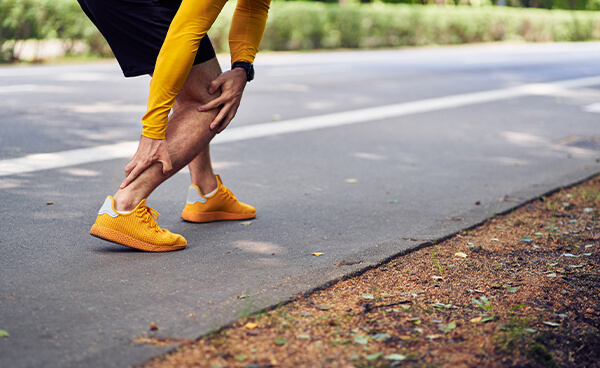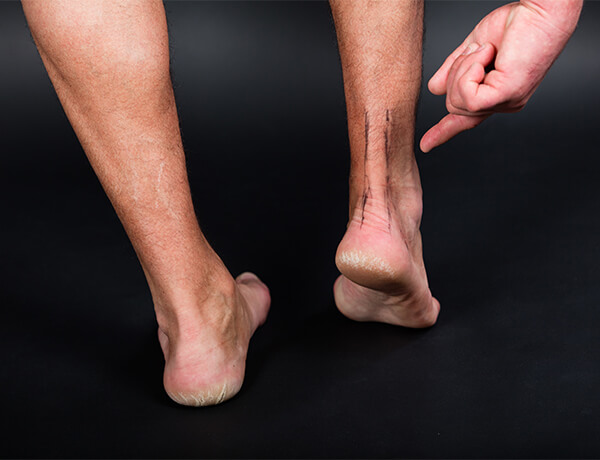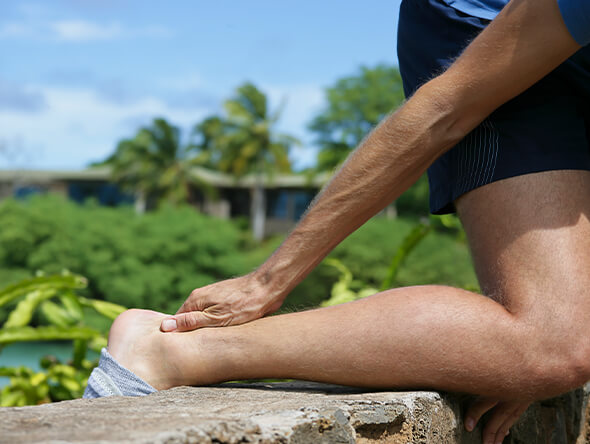Achilles Tendon Pain
How does Achilles Tendon Pain present?
Often, pain in the lower part of your leg can mean there is an inflammation or injury to the Achilles tendon.
There are many causes of Achilles tendon pain. Though anyone can develop pain in the Achilles tendon, it commonly affects active athletes, long distance walkers, weekend warriors or those resuming sporting activity after an inactive lifestyle.
It often presents with a very painful and inflamed tendon at the back of the heel upon waking or after exercise or walking


What is the Achilles tendon?
The Achilles tendon is the largest and strongest tendon present in our body. In general, tendons are fibrous tissues that connect muscles to bones, aiding movement.
Similarly, the Achilles tendon runs down the lower back of the leg, connecting the calf muscle to the heel bone. It aids movement such as walking, running, jumping and skipping.
Although it is the strongest tendon in the body, it is also very vulnerable to injury due to poor blood supply and the high loads it supports, which get transmitted through it
Symptoms of Achilles Tendon Pain
Symptoms can range from mild aching to severe pain in the back of the ankle or lower leg to the heel. The pain may also shoot up when you stretch or stand on your toes. Other symptoms are:
- Stiffness, soreness or weakness in the lower leg.
- Sharp pain in the Achilles tendon itself that restricts any kind of movement.
- Stabbing pain in the back of the ankle.
- Redness, swelling or other discomfort at the back of the ankle.

You must seek help urgently if there is any difficulty standing or walking, along with redness or swelling in the ankle.
Causes of Achilles Tendon Pain
The most common causes are:
- Achilles tendon tear
- Achilles tendonitis/tendinopathy
- Misaligned feet
- Diabetes
- Antibiotics (Fluoroquinolones i.e. Ciprofloxacin)- especially long courses
- Inflammatory conditions (such as Rheumatoid Arthritis/Psoriatic Arthritis)-Sometimes Achilles tendon pain is the only sign that you have an Inflammatory condition which can help get a diagnosis of the systemic condition.
Some Common Activities That Cause Achilles Tendon Pain
- Exercising heavily without warming up properly
- Playing high-impact sports or activities such as running, football (hard pitches), jumping/plyometrics
- A sudden increase in the intensity of exercise after a long lay-off or rest
- Sports such as Tennis that requires rapid movements (a lot of stop starts and turns)
- Wearing ill-fitting shoes especially if covering long distances walking or running
- Running on uneven surfaces or longer distances on a trajectory (such as uphill)
Diagnosis of Achilles Tendon Pain
An injury or pain in the Achilles tendon is often diagnosed after a physical examination of your foot and ankle and a few tests.
Clinically, the Thompson Calf squeeze test or Matles test are often used in the assessment stage to diagnose a rupture.
Your doctor may ask for imaging tests such as X-rays, Ultrasound or MRI to confirm the cause of this pain.
Ultrasound is a great modality for assessing the Achilles tendon. It is quick, painless and allows good visualisation. It is frequently used to diagnose tendon problems such as tendinosis, tendinitis, tears or bursitis (retrocalcaneal bursitis)
If the clinician suspects other associated conditions, such as an inflammatory condition or a possible infection, they may ask for blood tests to rule this out.
Treatment for Achilles Tendon Pain
- Medication:- There are many Non-steroidal anti-inflammatory drugs(NSAIDs) to relieve pain.
- Injections:- Your doctor may also suggest Platelet-Rich Plasma injections (PRP), Prolotherapy injections or Cortisone injections. Each can have a role in treating the pain at different stages.
- Physical Therapy:- Physical therapy is amongst the best treatment for treating the Achilles tendon as it gradually heals the tendon and calf muscles, easing the pain. It includes manual techniques, stretches and specific exercises.
- Eccentric Loading Exercise:- The eccentric training program, which involves stretching the tendon under load, shows significant results in treating pain and restoring the function of the Achilles tendon without strain. In particular the Alfredson protocol for Achilles tendon rehabilitation has shown excellent results in repair and rehabilitation.
- High Volume Hydro-dissection:- Hydro-dissection is a procedure that involves injecting a high volume of saline and anaesthetic solution(30-40mls) into the space between the Achilles Tendon and Kagars Fat Pad. The sensory pain nerves that attach to the Achilles tendon are therefore ‘stripped’ away from the tendon. The pain is often reduced following the procedure allowing more pain free flexibility and movement and a progression to rehabilitation exercises.
- Surgery:- Surgery is used to repair a full Achilles tendon rupture (although not always). After a full tendon rupture, surgery should be performed promptly. The danger of delaying tendon surgery in this situation is tendon shortening and scar tissue leading to permanent ankle stiffness and reduced range of movement. Your doctor will often recommend a rehabilitation program to strengthen and improve the flexibility of the tendons after surgery.
Frequently Asked Questions (FAQs)
When you participate in a physical activity such as running and suddenly increase the intensity or distance, you can end up straining and injuring the Achilles tendon. This can also be seen after resuming running after a long lay-off. This results in a condition called Achilles tendinitis. This causes soreness and weakness in the Achilles tendon.
Achilles tendon swelling is often due to overuse of the tendon. It may swell because of repetitive strain from high-impact activities such as running on hard surfaces or running long distances such as in football. It is important that rest and recovery is built into any exercise program to prevent this problem. This is to prevent Achilles tendonitis (tendon inflammation) which further can lead to Achilles tendinosis (tendon breakdown) and tendon degeneration.
If your Achilles tendon is suffering a mild injury, tear or inflammation, you may experience pain around your ankles, heels or lower leg when walking. Sometimes it can also be due to a strain in your calf muscles. If the pain increases with walking after home treatments and self-care, it is better to seek medical attention or get a scan.
High intensity exercise or repetitive exercises over a prolonged period can strain the Achilles tendon and cause pain. Obesity can be another reason for the pain. Furthermore, wearing inappropriate shoes for the activity may also contribute to the pain.
You can treat this pain at home by providing rest to the damaged tissue. Start by avoiding activities that strain them. You can also apply ice packs or take over the counter pain killing medication. However, if there is a sharp pain in the Achilles tendon along with swelling, or if your pain does not improve, you should consult a doctor immediately.
Conclusion
- Take adequate rest periods if you are following a heavy exercise regime
- Don’t forget to warm up and stretch the tendon before and after activities like running and long distance walking
- Incorporate variety into your fitness regime instead of repeating the same exercises
- Wear shoes that support your feet or get a running shoe assessment
- Strengthen your calf muscles
- Maintain a healthy weight
If you still develop pain after these measures, you can ease your pain by seeking expert advice.
MyMSK Clinic Treatments for Achilles Tendon Pain

Cortisone Injections
It is an anti inflammatory medicine which is injected during Achilles Tendon Hydrodissection.
Explore More
Prolotherapy
Prolotherapy is a regenerative treatment which can help with a degenerated Achilles Tendon.
Explore MoreIf you are suffering from Achilles tendon pain
Contact us at MyMSK Clinic on 0333 772 9655 or fill out our contact form.
Contact us
We’d love to hear from you!
Just reach out and contact us via any of
these channels:

Call us on

Email us on

Call us on


